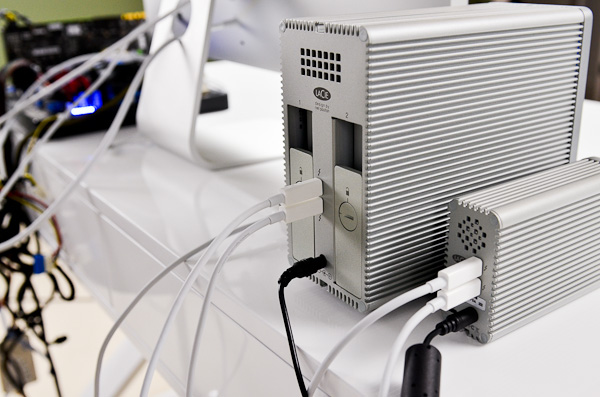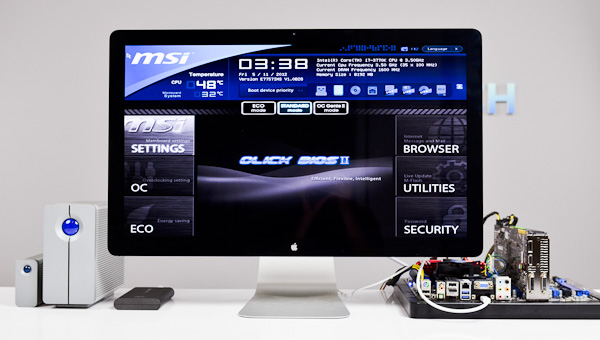A First Look at Thunderbolt on Windows with MSI's Z77A-GD80
by Anand Lal Shimpi on May 11, 2012 1:32 PM EST- Posted in
- Motherboards
- CPUs
- Intel
- MSI
- Thunderbolt
The Storage Devices & Performance
Other than Apple's Thunderbolt Display, every other TB device we've tested has been some sort of storage device. In my lab I've got Promise's Pegasus R6, LaCie's 2big and Little Big Disk (SSD), Seagate's GoFlex Thunderbolt adapter and Elgato's Thunderbolt SSD. With the exception of the Pegasus R6, which currently lacks Windows drivers, all of the storage devices I tested worked with MSI's Z77A-GD80 under Windows. Although there are workarounds for getting the Pegasus up and running under Windows, I encountered a number of hangs and general system unhappiness whenever I tried them on this platform. I suspect this has something to do with why Promise has yet to officially release Windows drivers for the Pegasus.
The rest of the storage devices, as you would expect, just worked. I didn't need to install any drivers as all of their internal controllers had native support under Windows 7. Again, I couldn't hot plug any of these devices once Windows was running - all of them had to be present at boot.
Just as I've seen under OS X, with complex Thunderbolt chains you'll sometimes have a device that hangs in the chain and prevents some or all TB devices from working. I did encounter this behavior more frequently under Windows than I did under OS X. Keep in mind that every single Thunderbolt device on the market today was pretty much developed and tested against Macs, it's going to be a little while before we get perfect behavior under Windows. We don't even have perfect behavior under OS X yet either. My hope is that as more platforms ship with Thunderbolt support, and as we get more Thunderbolt devices, compatibility and behavior validation will both improve. I've also heard that the early Thunderbolt controllers were more finicky than Cactus Ridge, so it's possible that newer TB devices that come out this year will just inherently be better behaved. This is purely hearsay however, I don't have any hard evidence to back it up.
Update: Intel tells us that an updated Pegasus driver is in the works that will address the issues we've seen. Other finicky behavior is also expected to be addressed through the Thunderbolt on Windows certification process.
Since I couldn't get the Pegasus working, I had to resort to combining a bunch of my other Thunderbolt storage devices to measure performance. I created a chain combining LaCie's 2big, the SSD Little Big Disk and Elgato's Thunderbolt SSD along with Apple's Thunderbolt Display. I ran a 128KB sequential read test at a queue depth of 32 across all of the drives, while pushing the Thunderbolt Display at its native 2560 x 1440 resolution:
The best I ever got under OS X was 8Gbps using four SandForce SSDs in the Promise Pegasus. At 7Gbps using a far less elegant setup, this isn't bad at all. Keep in mind that while we're reading at 7Gbps, the GD80 was also using around 7Gbps of bandwidth to drive the Thunderbolt Display at 2560 x 1440. Total available bandwidth for a single-port Thunderbolt device is 20Gbps bi-directional (40Gbps total), so there's still additional headroom available.
Moving Forward
MSI's Z77A-GD80 finally brings Thunderbolt to Windows desktops. With a few exceptions, the experience is quite similar to OS X. The major differences are that some devices clearly need more compatibility testing with these new platforms, and that you can't hot plug Thunderbolt devices under Windows. The former is solvable given additional time, while the latter can be more annoying in the long run if a workaround isn't found. For a single, high-speed storage device under Windows, USB 3.0 is going to be the simplest route. It's only when you want to start pushing even more bandwidth and/or add a display into the mix that Thunderbolt becomes your only solution.
Thunderbolt's functionality otherwise looks very similar under Windows as it does under OS X. The interface doesn't require any specific drivers and in the best conditions it just works. Thunderbolt's behavior remains quite finicky however, even more so under Windows. You'll want to wait for either the next generation of Thunderbolt devices or for the current device vendors to get some more time validating their Thunderbolt products on Windows platforms. Given that the first Thunderbolt equipped PC motherboards haven't even shipped yet, you've got some time.
Update: Intel has informed us that we will see updated drivers for Windows certified Thunderbolt devices that will enable hot plugging under Windows. Intel further informed us that MSI's board has not yet made it through the certification process and a lot of these teething issues will hopefully be addressed by then.
For much of the past year I've been calling for cheaper Thunderbolt storage devices, but with the arrival of Thunderbolt on Windows I'll modify my plea: we need more Thunderbolt display devices as well. As the desktop PC evolves, it would be nice to have only a single cable running from your PC to a Thunderbolt equipped display that acts as the IO hub for all of your peripherals. I'm thinking of something like Apple's Thunderbolt Display, but even heavier on the expansion side and with OS-independent display controls.













98 Comments
View All Comments
AnTech - Saturday, May 12, 2012 - link
It should be possible to power on a computer from a Thunderbolt port, as was previously possible with Macs using a device like the i-Cue for USBhttp://www.lindy.co.uk/usb-boot-dongle-i-cue-for-m...
or the former ADB Apple keyboards that also allowed powering on the Mac from them. That is really convenient when the computer is away and difficult to reach, below the table, etc.
rikm - Saturday, May 12, 2012 - link
First page says: Co-developed by Apple and Intel, Thunderbolt is a tunnel that carries both PCIe and DisplayPort traffic to the tune of 20Gbps per channel (10Gbps up and down).Page 3 says: Total available bandwidth for a single-port Thunderbolt device is 20Gbps bi-directional (40Gbps total), so there's still additional headroom available.
Which is it?
KitsuneKnight - Saturday, May 12, 2012 - link
It's 10Gbps up or down per channel. So 20Gbps per channel.There's 2 channels, so there's a total, aggregate bandwidth of 40Gbps in both directions.
So it's both.
buzznut - Saturday, May 12, 2012 - link
This is a very vanilla looking board for around $200. And the PCI-express lanes are pathetic. They choose to implement Thunderbolt on a motherboard with how many lanes??I like msi so I really don't understand this. And for some reason, Intel motherboards in general don't provide enough PCIx lanes. As features are added, it seems like they limit the lanes even more. What gives?
In my opinion, someone would have to be pretty desperate to have Thunderbolt in their system if this board is representative of most implementations. Sure, its a new technology but this is indicative of a larger problem-Intel had the same problem with their implementation of USB 3.0; not enough PCI express lanes. A person would be foolish to use this board with crossfire or sli.
ggathagan - Saturday, May 12, 2012 - link
Why desperate ?I think many are not understanding ThunderBolt.
It's not a device in-and-of-itself, it's a flexible bus mechanism that's fairly protocol-independent.
You're viewing it as something that consumes x4 PCIe lanes, eliminating their use by another device.
That's not accurate.
In the case of this board, it allows you to use the 4x bandwidth for USB, firewire, SATA, DP, gigabit ethernet or any combination thereof.
If a motherboard vendor chose to do so, they could link it to a PCIe 3 x16 lane and still not utilize TB's full bandwidth.
Given the tests that show little or no difference in PCIe 2 x8 vs x16 performance, that opens a LOT of possibilities.
repoman27 - Sunday, May 13, 2012 - link
Ivy Bridge LGA 1155 CPU's provide 16 PCIe 3.0 lanes for dGPU use, which is pretty much twice the bandwidth that came with Sandy Bridge and plenty for most setups.The PCH continues to offer 8 PCIe 2.0 lanes for additional features, which is about all that is reasonable given the 20 Gbps limit of the DMI 2.0 connection to the CPU. The more features a motherboard manufacturer adds, the more of these lanes they consume, and the fewer that are left available to the end user as open PCIe slots. By my count, MSI have used 6 of the 8 lanes branching off of the PCH by adding Thunderbolt, FireWire and an additional SATA 6 Gbps controller.
If you really think 16 GB/s of bandwidth isn't enough for your particular CrossFire or SLI setup, you can always go with an LGA 2011 solution which would give you 40. The bottom line is that if you want more PCIe lanes, you need a bigger socket with a lot more pins to provide those connections, and that ain't cheap.
richard451 - Saturday, May 12, 2012 - link
It's odd that the article states multiple times that Thunderbolt does not need any drivers for the OS to take advantage of it, yet the update from Intel states once Windows gets updated Thunderbolt drivers things will improve.ggathagan - Saturday, May 12, 2012 - link
The comments about drivers from Intel revolve around extending hot-swap capability to TB-connected devices.Much like hot-swap AHCI is supported in Windows 7 while not in XP, the basic functionality for the connectivity in W7 is due to TB connections being seen as a PCIe device or a DP device in W7, while the hot-swap functionality has to be achieved through drivers.
I suspect Windows 8 might have said capability built in.
I doubt MS is interested in doing the same for W7, since they want us all to move forward on their 'enlightened' Metro path.
repoman27 - Sunday, May 13, 2012 - link
To clarify, the Thunderbolt controller does not require any drivers, but the devices you connect via Thunderbolt may.Thunderbolt devices tend to include PCIe hardware for which Windows drivers already exist, but the drivers were not designed with hot-plugging in mind. Once the drivers are tweaked to support hot-plugging, the devices won't require a restart in order to be recognized by the system, and will become eligible for Thunderbolt certification for Windows.
It's the drivers for the PCIe connected hardware in the Thunderbolt devices that need updating in order to work properly in the new Thunderbolt context.
SimoxTav - Saturday, May 12, 2012 - link
May I suggest to take a look at the performance videos of the eGPU solution listed on the topic?http://forum.notebookreview.com/8267588-post1.html
Check the "1.2Opt-Int" videos (scroll down) that means "x1 PCI 2.0 + Optimus Compression on internal screen". The results are IMHO quite enjoyable with a GTX560. With Thunderbolt can only be better (and easier to be implemented). Currently the performance are about 75-80% of the x16 counterpart (obviously depending on the specific game).